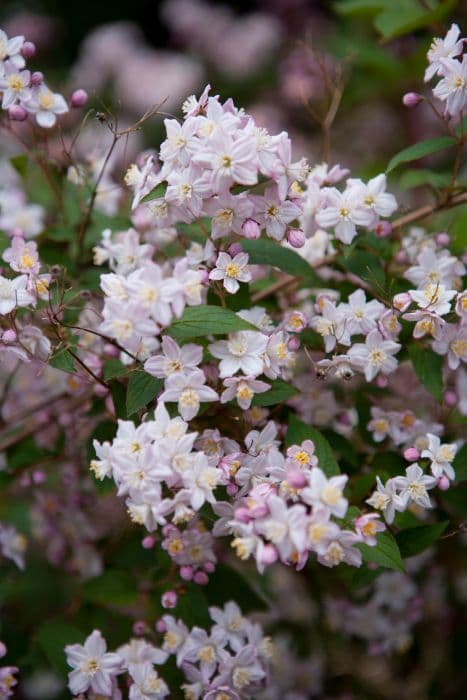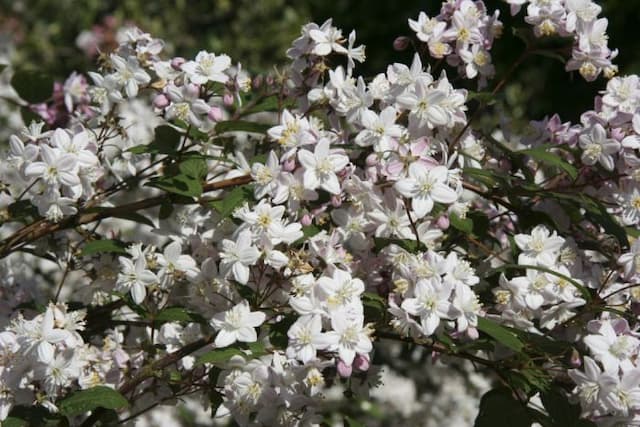Bigleaf Hydrangea Hydrangea macrophylla 'Mariesii' (L)

ABOUT
Hydrangea macrophylla 'Mariesii' is a visually striking plant commonly known as bigleaf hydrangea. One of the most distinctive features is its large, broad leaves that are deep green in color, providing a luscious backdrop for its flowers. Throughout the blooming season, which often occurs in summer, the plant produces rounded flower clusters known as mophead inflorescences. These blooms can exhibit a range of colors depending on the soil pH; they may appear in various shades of blue, pink, or even purple. The individual flowers within these clusters are relatively small, with a delicate, almost papery texture. They are tightly packed to form a dense, globular shape that gives the impression of a large, single bloom. This contrasts beautifully with the dark green foliage and can create a stunning ornamental display in gardens and landscaped areas.
About this plant
 Names
NamesFamily
Hydrangeaceae.
Synonyms
Bigleaf Hydrangea, French Hydrangea, Lacecap Hydrangea, Mophead Hydrangea, Penny Mac, Hortensia.
Common names
Hydrangea macrophylla 'Mariesii'.
 Toxicity
ToxicityTo humans
Hydrangea, the common name for Hydrangea macrophylla 'Mariesii', contains cyanogenic glycosides, which can release cyanide when the plant is chewed or digested. Ingesting parts of the plant, particularly the leaves and buds, can potentially cause symptoms of cyanide poisoning in humans. These symptoms may include dizziness, confusion, an increase in heart rate and breathing rate, and nausea, which can lead to vomiting and diarrhea. In severe cases, seizures, coma, and even death could occur if a significant amount of the plant is consumed.
To pets
Hydrangea, also for pets, contains cyanogenic glycosides which may release cyanide when ingested, posing a risk to animals. If pets eat parts of the hydrangea, it can lead to symptoms of toxicity which include lethargy, vomiting, and diarrhea. In some cases, more severe symptoms such as depression, cyanosis (bluish discoloration of the mucous membranes due to insufficient oxygen in the blood), abdominal pain, and in extreme cases, seizures and coma may occur. If you suspect your pet has ingested hydrangea, it is important to seek veterinary care immediately.
 Characteristics
CharacteristicsLife cycle
Perennials
Foliage type
Deciduous
Color of leaves
Green
Flower color
Varies
Height
4-6 feet (1.2-1.8 meters)
Spread
4-6 feet (1.2-1.8 meters)
Plant type
Shrub
Hardiness zones
6-9
Native area
Japan
Benefits
 General Benefits
General Benefits- Aesthetic Appeal: The Hydrangea macrophylla 'Mariesii' adds striking visual interest to gardens with its beautiful large, rounded flower heads that can range in color from pink to blue, depending on the soil pH.
- Versatile Landscaping: Suitable for borders, as a focal point, or in mass plantings, Mariesii offers flexibility in garden design.
- Attracts Pollinators: The blossoms attract bees, butterflies, and other pollinators, which are essential for a healthy and vibrant ecosystem.
- Seasonal Interest: Provides a long blooming season, typically from early summer to late fall, offering sustained splashes of color in the garden.
- Shade Tolerance: Can grow in full sun to partial shade, making it adaptable to different garden locations.
- Durable: Hydrangeas are known for their hardiness and can last for many years with proper care.
- Propagates Easily: Can be propagated from cuttings, allowing gardeners to produce more plants economically.
 Medical Properties
Medical PropertiesThis plant is not used for medical purposes.
 Air-purifying Qualities
Air-purifying QualitiesThis plant is not specifically known for air purifying qualities.
 Other Uses
Other Uses- Hydrangea macrophylla 'Mariesii' leaves can be used to create a natural green dye for textiles, offering a sustainable coloring solution for fabrics.
- The wood of Hydrangea macrophylla 'Mariesii' is sometimes used in small scale crafting or woodworking projects due to its interesting grain patterns.
- Dried hydrangea flowers are incorporated into potpourri mixes for their ability to retain color and shape, adding aesthetic value to the mixture.
- Hydrangea leaves can be used in composting to help add bulk and structure to the compost pile, promoting better aeration and decomposition.
- Pressed hydrangea flowers are often used in art and craft projects, such as greeting cards or bookmarks, due to their vibrant colors and detailed structures.
- Hydrangea plants can be used in landscape design to create stunning hedge borders or for erosion control due to their extensive root systems.
- The vibrant blooms of hydrangeas are popular as natural confetti for outdoor celebrations, as they are biodegradable and add a splash of color.
- Stems of Hydrangea macrophylla 'Mariesii' can be woven into decorative wreaths or garlands when they are flexible, offering a rustic and natural decor option.
- The large leaves of hydrangeas can be used as a natural wrap for outdoor cooking, infusing a subtle flavor into the food while it steams.
- Included in floral water displays, the floating blooms of hydrangeas can create a focal point for tranquil and elegant water features in gardens.
Interesting Facts
 Feng Shui
Feng ShuiThe Hydrangea is not used in Feng Shui practice.
 Zodiac Sign Compitability
Zodiac Sign CompitabilityThe Hydrangea is not used in astrology practice.
 Plant Symbolism
Plant Symbolism- Understanding: In Japan, the hydrangea is associated with an apology or the emotion of understanding, due to a Japanese legend of a grateful emperor who gifted them to express his apologies and gratitude to the family of a girl he loved.
- Heartfelt emotions and gratitude: The full shape of the flower and its various colors represent the many emotions that can fill one's heart, as well as the idea of expressing thanks.
- Vanity or boastfulness: In Victorian times, sending hydrangeas could mean the sender was accusing the recipient of being boastful or vain, playing off the abundance of petals and the plant's showy nature.
- Perseverance: Hydrangeas bloom from early spring to late autumn, which can symbolize a person’s ability to endure and persist over time.
- Frigidity and heartlessness: In some negative interpretations, hydrangeas could imply frigidity and lack of empathy, perhaps tied to the Victorian meaning or the coolness of its blue varieties.
 Water
WaterThe common name for Hydrangea macrophylla 'Mariesii' is Lacecap Hydrangea, and it prefers consistent moisture. You should water this plant with about 1 gallon of water per week, especially in the absence of rain. In hotter climates or during dry periods, it may require more frequent watering, perhaps twice a week, to keep the soil moist but not soggy. Ensure that you water directly at the base of the plant to avoid wetting the leaves, which can lead to fungal diseases. During the winter, reduce watering as the plant requires less moisture due to dormancy.
 Light
LightLacecap Hydrangeas thrive best in morning sun with afternoon shade or dappled sunlight throughout the day. They should be placed in a location where they are protected from the hot afternoon sun, which can scorch their leaves. An ideal spot is on the east or north side of a building or under the light shade of tall trees.
 Temperature
TemperatureLacecap Hydrangea does well in a range of temperatures, but prefers a consistent environment. It can tolerate a minimum temperature of about 5°F but should be protected from harsh winter winds and extreme cold, which can damage the buds. The ideal growing temperatures are between 65°F and 75°F. They can survive brief periods of higher temperatures, as long as they are well-watered and shaded from the intense afternoon sun.
 Pruning
PruningLacecap Hydrangeas should be pruned to remove dead wood and shape the plant, usually in late winter or early spring. These hydrangeas bloom on old wood, so it's important to only prune after the flowers have faded, and avoid cutting off the buds for next year's blooms. Deadheading spent flowers will encourage additional blooms and help maintain a tidy appearance. Prune out any weak or crossed branches to improve air circulation within the plant.
 Cleaning
CleaningAs needed
 Soil
SoilThe best soil mix for Hydrangea, commonly known as Bigleaf Hydrangea, should be rich in organic matter, well-draining, and moist. It prefers a soil pH around 5.5 to 6.5, as pH influences flower color—more acidic soils result in blue flowers, while alkaline soils lead to pink flowers.
 Repotting
RepottingBigleaf Hydrangeas should generally be repotted every 2-3 years to refresh the soil and accommodate root growth. However, if the plant is growing vigorously, yearly repotting may be necessary.
 Humidity & Misting
Humidity & MistingBigleaf Hydrangea thrives in moderate to high humidity levels. Maintaining humidity around 50-60% is ideal for these plants to flourish.
 Suitable locations
Suitable locationsIndoor
Place in bright, indirect light with high humidity.
Outdoor
Plant in morning sun with afternoon shade and shelter.
Hardiness zone
6-9 USDA.
 Life cycle
Life cycleThe common name for Hydrangea macrophylla 'Mariesii' is Lacecap Hydrangea. The life cycle starts with seed germination, where the Lacecap Hydrangea begins its life as a small seedling, usually in spring or early summer. After germination, it enters the vegetative stage, growing leaves and stems, and establishing a strong root system; this stage can last for several years as the plant matures. Once mature, the hydrangea enters the flowering stage annually, typically from early summer to late autumn, producing large, distinctive flowers with a lace-like appearance. After pollination, these flowers will develop into seed capsules if conditions are favorable. During autumn and winter, the plant may enter a period of dormancy, shedding leaves and conserving energy until the next growth cycle begins in spring.
 Propogation
PropogationPropogation time
Spring-Early Summer
The most popular method for propagating Hydrangea macrophylla 'Mariesii', commonly known as Lacecap Hydrangea, is through softwood cuttings. This is typically done in late spring or early summer when new growth is still tender. Cuttings are taken from healthy, new growth that has not yet flowered, making sure each cutting is about 5 to 6 inches (around 12.7 to 15.2 centimeters) in length. Lower leaves are removed, and the cut end is dipped in rooting hormone to encourage root development. The cuttings are then placed in a mixture of moist potting soil and sand or perlite. The environment must maintain high humidity, which can be achieved by covering the cuttings with a plastic bag or dome. Roots generally develop within 6 to 8 weeks, after which the young hydrangeas can be transplanted to larger pots or directly into the garden.






![Hydrangea [Early Sensation]](/_next/image?url=https%3A%2F%2Fplants-admin.emdemapps.com%2Fimages%2Fplants%2F%2Fimages%2F604b6150338db.png&w=640&q=75)


